The Strange Talent of Luther Strode tpb (Image, $14.99)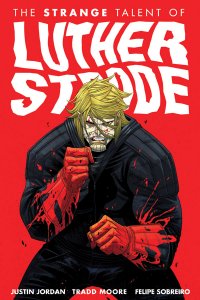
by Graig Kent
I would hesitate to call anything Mark Millar has ever done as seminal. Popular, sure, but seminal? Thing is, popularity has a tendency to breed influence, and no matter how middling Millar’s high-concept, juvenile, ultra-violent ouevre is, invariably there are going to be people inspired by his brand of over-the-top, irony-heavy storytelling. I can’t say for certain that writer Justin Jordan is a Millar acolyte, but The Strange Talent of Luther Strode certainly reads like an Asylum Films version of Kick-Ass, or perhaps an interpretation of the question I don’t believe anyone was asking; “what if Mark Millar created Flex Mentallo instead of Grant Morrison?”
As the back cover blurb summarizes so efficiently, “Luther Strode is just your average geek, until he send for an exercise course from the back of an old comic book.” What that exercise course leads to is Luther’s untapped potential to see and react to situations with superhuman agility, and to spot the weaknesses of everyone he faces. Naturally Luther faces off against his high school bully and wins, while also winning over the girl he’s had a crush on. From there, of course, he wants to be a “real life” superhero, where things just never seem to go like they do in the comics, especially since there’s a shadowy organization keeping tabs on him for either recruitment or elimination.
Luther Strode is a by-the-numbers affair, working over such well-worn cliches that one has to wonder if there’s anything left of that dead horse to flog. There’s next to no innovation, little plausibility and certainly none of the cleverness it seems desperate in hoping it has. To Jordan’s credit, it is a well paced, solidly dialogued book, but the story itself it’s been done so many times before, it’s like it’s the product of the “geek-power-fantasy” template that comes standard in Microsoft Word.
If there’s a saving grace to the book’s mundanity, it’s Tradd Moore’s surprisingly well-formed and distinct cartooning style. Image has been home to a plethora of new artists as of late coming out of the gate with their first works exhibiting individualistic sensibilities and fully professional quality, and Moore is definitely the latest in that line. He’s got an angular line stile, working with fine, thin edges that are purposeful in how they define the details of a scene or character. There are elements of artists like Tomm Coker, Tan Eng Huat, John Romita Jr. and Ryan Ottley, but Moore truly has his own thing going. There’s absolute confidence on display here and a dexterity that could see him (with the right pairing) becoming a top-caliber Marvel artist or a major indie creator or even a go-to genre illustrator at Vertigo.
Even with Moore’s endlessly intriguing art, the story is such a routine drag that’s it’s difficult to recommend.
Rating: 




Out of a Possible 5 Stars
 Planet of the Apes #12 ($3.99, BOOM!)
Planet of the Apes #12 ($3.99, BOOM!)
By D.S. Randlett
Rod Serling and his associates made Planet of the Apes a great concept. What should have been a goofy adventure film became one of the most famous, and one of the finest, scif-fi fables ever put to film. Serling imbued the concept with a social consciousness that it may have otherwise lacked, but they also went beyond that. In a way, they made the concept about history and how it feels to be living it. Sure, there’s Charlton Heston’s character, who functions as a sort of living artifact in the first film, but there is also a raft of supporting characters who function as different images of historical discontent. Even Doctor Zaius, the first film’s villain, has understandable motivations for keeping the secrets that he does, and there’s a sense that he’s not entirely happy with that particular obligation. If Planet of the Apes is about anything, it’s about individuals swept up in an uncaring universe of institutions, events, and prejudice. They may try to break free, but the tragedy at the franchise’s center won’t ever really let them.
It’s that subtlety, and the willingness to follow in Serling’s footsteps, that’s a big part of what’s been making Daryl Gregory and Carlos Magno’s run on Boom’s POTA series one of the best series on the shelves. But they also manage to bring a lot to the series that their forebears have never really been able to. For one, they’re able to go a lot bigger, giving this series a sense of epic scope typically reserved for Fantasy novels. But they still manage to capture that scope while making this story feel personal, like its characters matter. Magno’s art certainly doesn’t hurt the cause, as his detailed style impressively captures widescreen action. But his characters are also good actors, their expressions imbuing actual inflection in Gregory’s dialog.
This twelfth issue marks the beginning of a new arc, so if you want to jump on, do it now. I assure you, you’ll be looking for back issues in no time. This issue does a good job of opening the door for new readers, as there’s something of a new status quo here. As a long time reader this doesn’t feel so much like a slight as it does an unexpected, but still organic, progression in the increasingly novelistic story. The stakes for the characters have gotten higher, the world is expanding, and the situation feels appropriately dire.
Month in, month out, Planet of the Apes is a must read, and it hasn’t let me down yet. If it’s not part of your pull list yet, make it so.
Rating: 




Out of a Possible 5 Stars
RED HOOD AND THE OUTLAWS #8 (DC Comics, $2.99)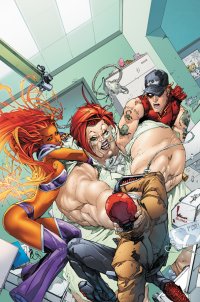
By Devon Sanders
Call me insane but I sort of like DC Comics’ Red Hood and The Outlaws. Is it gratuitous in every sense of the word? Yes.
It’s (pardon the pun) quite literally, Bat-sh*t insane. It’s basically the adventures of a former Robin, Jason Todd, working out his daddy issues after being killed by The Joker and then, of course being brought back to life. Add to the mix, former teen hero/gun-for-hire and ex-heroin addict Roy Harper and Starfire, a space princess with boundary issues and well, you get probably the most Marvel comic out there not actually published by Marvel. In short, it’s a bizarro Teen Titans/Hangover comic set in a bizarro DC Universe. Or as it’s currently being called, “The New 52.”
In this month’s Red Hood and The Outlaws #8, they’re revisited by Suze Su, a 500-plus pound mobster Red Hood left for dead after she took offense to his taking over her crime family. Seems she’s taken over a hospital ward full of children and threatens to kill them all if Red Hood doesn’t show up. Will the former Robin who cares about nothing but himself and revenge find it within his heart to channel his inner Wu-Tang and become for the kids?
Red Hood and The Outlaws #8 is just simple, plain ridiculousness and you know what, I enjoy it. Question my sanity, go on but it’s so unapologetic in its hyper-everything that it’s hard not to find something to like. Writer Scott Lobdell gets that this isn’t Watchmen and just gets down to writing the comics. These characters are conflicted and know it and frankly, I applaud him for giving them this self-awareness. Especially nice is a flashback scene between Red Hood and former Robin and current Teen Titan, Tim Drake/Red Robin. It shows a genuine care between these two that recalls the brotherly bond shared between Drake and Dick Grayson, pre-New 52. It’s a nice change of pace and provides a bit of depth to these two characters that’s sorely been missing of late.
The biggest draw here (pardon the pun, again) is the art of Kenneth Rocafort. Rocafort’s line is ridiculously fluid and perfect for this type of non-stop action comic. Especially nice is his understanding of what the page calls for; if one page needs kicks, it gets kicks. If another needs two characters sitting down to breakfast, Rocafort transitions them both easily with the reader’s eye in mind.
In short, if you need your comics full of the hoity and the toity and sometimes, things that make sense, Red Hood and The Outlaws may not be the book for you. Now, if you simply want a superhero comic that seems to enjoy being a superhero comic, then this is a comic you may want to check out.
Rating: 




Out of a Possible 5 Stars
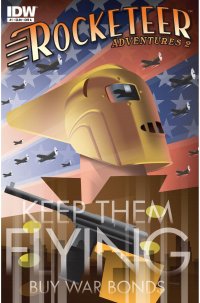 Rocketeer Adventures 2 #1-2 (IDW, $3.99)
Rocketeer Adventures 2 #1-2 (IDW, $3.99)
By Adam Prosser
As we’ve all been made well aware over the past few months, no comic book character ever truly goes away. This is particularly true at Marvel and DC, which have basically become gigantic IP farms more than they are publishers, but it’s becoming increasingly true of creator-owned characters as well. This can be a good thing or a bad thing—on the one hand, it’s a little ghoulish to see characters endlessly recycled, but on the other hand, a good concept is a good concept, and as comics have proven in the past, characters can actually be improved in later hands than their creators.
One character who hasn’t been very prominent of late is The Rocketeer, a character who was backwards-looking right from the start and who never really achieved the A-list, despite a cult following (due largely to the unsuccessful but beloved 1991 movie). Of course, that’s partly because the aforementioned movie, which even as a relative flop had the potential to elevate the character in the comics world, came at arguably exactly the wrong time—comics in 1991 were all about the Image-style violence and deconstruction, not a whimsical salute to old-fashioned Golden Age comics and movie serials (with or without sexy bondage queens). By the time comics entered their nostalgic phase a few years later, the bottom had dropped out of the indie comics market, so it was never really worth creator Dave Stevens’ while to keep new content coming. And just as the industry-wide search for recognizable content started to hit a fever pitch, Stevens died of hairy cell leukemia, in 2008, at a tragically young age.
As mentioned, though, the call for familiar characters to use in “new” comics series is only getting stronger, and thus, IDW has launched a new series of Rocketeer tribute comics with some major talents involved—Bill Seinkiewicz, Stan Sakai, and Paul Dini are among the contributors to these two issues.
There’s a bit of a problem here, though: these are very short stories featuring a character who wasn’t enormously fleshed out in the first place, and as a result, there simply isn’t that much room to do anything hugely interesting with the stories. Instead, these issues are a showcase for some often spectacular art (Sandy Plunkett, who opens the first issue, is particularly good at capturing Stevens’ style, and Colin Wilson, in the second issue, adds a nice sense of grit without losing the clear, classical feeling a Rocketeer adventure should have) depicting WWII era pulp technology, classy 30s cars and fashions, and Bettie Page. There’s also a bit of a fetishization of the idea of comic book heroes of the kind I sometimes kind a little irksome, though it’s easier to take these days when it’s not coming from sleazy publishers like DC and Marvel.
There’s been one exception so far: Seinkiewicz’s typically anarchic artwork illustrates a Peter David-scripted story about a Daffy Duck-style Rocketeer cartoon parody (“The Ducketeer,” naturally) which, just for a moment, tries to do something new with the character. But mostly, the combination of this book’s being dated-by-design with the stories too short to build up a good head of action-adventure steam lead to a curiously inert experience. It’s like a perfectly restored classic aircraft sitting in a museum: beautiful to look at, but you’re not going to be allowed to take it anywhere.
Rating: 




Out of a Possible 5 Stars
Reset #1 ($3.99, Dark Horse)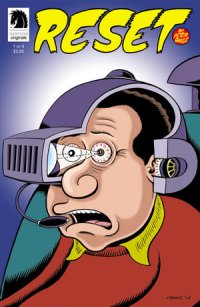
By D.S. Randlett
I’ve always been more or less on the fringes of Peter Bagge’s work. This has always been something of a reason for shame to me, as our senses of humor seem to be so in sync. Over the years, it’s been more a question of access than anything, as my local retailers over the years haven’t been so keen on carrying Hate. There was a series of cartoon shorts that he did with Dana Gould in 2001 that were pretty definitive for me. I was a teenager then, and seeing that short series, Murray Wilson: Rock and Roll Dad didn’t quite form my sense of humor, but it definitely showed me that someone thought that washed up house punching sixties alcoholics were as funny as I did.
From what I’ve read of Bagge, including Reset, he’s very interested in that sense of washed upness that follows his characters. They tend to be bitter (you can tell from his illustrations alone), and they speak like a certain type of stand up comic. Bagge’s writing has the mood of Louis C.K., but it has the voice of an older era of comedians like Don Rickles or Joan Rivers. I don’t quite know what to say about his illustrations except that they basically have the same voice as his writing, just manifested in a different form. At one moment his art is laughing at his characters, and in the next it’s sympathetic. More often it contains both sentiments at once, imparting a feeling of jaundiced fellowship that most great stand up comics employ.
Reset sounds like its going to be a bit gimmicky at first. A washed up comedian is attending Alcoholics Anonymous (he was pulled over for a drunk driving offense that he insists he didn’t commit) where he is approached by a young research scientist. She wants to test a game that she is creating that will allow players to relive their own lives, and make different decisions at crucial points. It sounds kind of like a mundane version of Mass Effect, but the MacGuffin here functions more like the one in Eternal Sunshine of the Spotless Mind, as a vehicle for telling the story of a character’s experience within a certain emotional milieu.
At least it would if the main character were a little more compliant. He’s constantly pushing the reset button, starting the game over to its first moments (his high school graduation). This is where the book really starts coming into its own and shaking off the expectations of its premise. The game ends up as not so much a flashback device, but as a metaphor for those regret-tinged memories that we all seem to be infected with. They’re like mouth sores, which we can’t seem to stop prodding and reopening. These are some of the sharpest and funniest bits of Reset because they ring so true. These scenes in the game are crudely drawn, evoking the incompleteness of memory, but also its raw absurdity.
Reset reads like great stand up. You go in a few expecting jokes, but walk out with a bit of understanding and pathos. What at first glance seems like impotent bitterness is revealed as sadness comingled with a sense of tragic anger. In the face of that, all that you can really do is laugh.
Rating: 




Out of a Possible 5 Stars
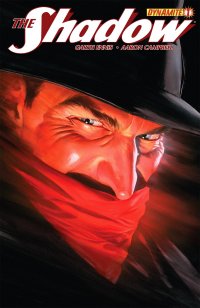 The Shadow #1 (Dynamite, $3.99)
The Shadow #1 (Dynamite, $3.99)
By Jeb D.
Even knowledgeable comics fans can have trouble sorting out which aspects of the Superman mythos originated with Siegel and Shuster and their four-color successors, and which were grafted on from other media, like the popular radio series (kryptonite, among other things); The Shadow’s background makes Supes’ continuity feel positively straightforward.
The Shadow began not as a character, but as the deep-voiced announcer of a mystery anthology series on radio. When the popularity of this faceless voice took off, publisher Street and Smith commissioned a young, but already veteran pulp writer and semi-professional magician named Walter Gibson to turn the ominous voice into a character that could star in his own adventure magazine. Gibson, who may, as far as I know, still hold a Guinness record for number of words produced in a year, was tasked with turning out a full-length Shadow novel each month (while continuing to write Westerns, detective and sci-fi tales for other magazines), and the results were some of the most amazing fiction of the pulp era: written in machine-gun bursts of energy, with little to no evidence of rewriting, Gibson’s stories posited a mysterious cloaked avenger, equipped with twin .45 automatics and no mercy, at the head of a small band of devotees, facing down all manner of weird villainy, with a background that involved a bewildering sequence of identities (some secret, some not so much, and even the supposed “original” one was later contradicted), and strange powers that might or might have supernatural basis (Gibson never seemed quite sure). Eventually, the character made his way back to radio, but with most of Gibson’s contributions tossed aside: radio’s new Shadow had no secret organization, packed no heat, and was reduced to a single secret identity of the most obvious sort: the Bruce Wayne-style millionaire playboy Lamont Cranston (in the pulps, Cranston was a genuine playboy who allowed The Shadow to “borrow” his identity from time to time), with a conventional hero’s girlfriend/sidekick, Margo Lane (who was then retconned uncomfortably back into the pulps). His strange abilities were reduced to the power to “cloud mens’ minds so they cannot see him”; and the stories were usually fairly typical murder mysteries, with The Shadow’s contribution limited to showing up in the last five minutes to cackle one of his overused catch phrases in his disembodied voice (“the weed of crime bears bitter fruit”) to scare the bad guy into falling victim to his own deathtrap.
Given the messy nature of The Shadow’s genesis, it’s not surprising that the character’s career in the comics has been spotty: whether Kaluta’s classic noir, or Chaykin’s sci-fi satire, even top-notch creators have had difficulty finding the through-line that would sustain an ongoing series when the character’s core is so mushy. While Garth Ennis was certainly a natural for the hard-boiled violence of Gibson’s pulp version, I’m particularly impressed with the way that this first issue seems to effortlessly blend it with the more familiar elements drawn from the radio show, in one of the tightest, best-focused scripts I’ve read from Ennis in some time.
The 1940’s setting was a good choice, and Ennis demonstrates right off that he’s playing for much higher stakes than similar previous series from DC or Dark Horse: the comic opens with a bleak portrayal of the Japanese invasion of China, the notorious “rape of Nanking.” In the wake of such real-world horror, The Shadow’s subsequent encounter with Japanese espionage agents in New York is appropriately brutal and blood-soaked. Ennis adopts the familiar Cranston identity, but this version of the millionaire is less the effete playboy than the behind-the-scenes power player, bandying dark conspiracies with Federal agents, and it won’t be at all surprising to eventually discover that this is yet another mask. Ennis also addresses the question of The Shadow’s mystical abilities, but in a way that leaves the character, and readers, with more to discover about them. While such familiar names from the pulps as Moe Shrevnitz and Harry Vincent are referenced, the other key member of the supporting cast that we meet is Margo Lane, whose relationship with Cranston is clearly deeper and more complicated than either Gibson or the radio writers chose to explore, and their dark, intense scene together at the end of the issue provides backstory both historical and psychological.
Artist Aaron Campbell (with colors by Carlos Lopez) has clearly studied his period reference material. He lacks Kaluta’s pulpy noir feel, and while his storytelling and camera angles carry Ennis’ script efficiently enough, there’s a spark of electricity in the writing that I’m not feeling in the art, at least not yet.
In the end, it has to be admitted that revisiting yet another well-worn character from days gone by may be of limited value for a lot of readers, but Ennis’ enthusiasm for the character, and confident plotting, do the job about as well as you could ask.
Rating: 




Out of a Possible 5 Stars
The Avengers #25 (Marvel, $3.99)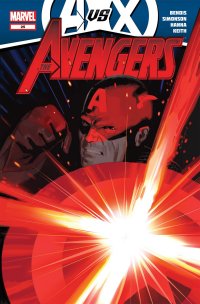
By Jeb D.
The corporate superhero assembly line generally works pretty efficiently when the writing and drawing are handled separately; guys like Brian Bendis and Geoff Johns can turn out scripts fast enough to keep a small cadre of artists busy, so that the marquee names can appear on several books a month. There’s the occasional exception, of course (Darwyn Cooke comes to mind), but there was a time when the writer-artist wasn’t such a rarity on the monthly comic scene as they are today, and fans have fond memories of the visionary work that Walt Simonson did writing and drawing books like Fantastic Four and Thor (Warren Ellis once opined that if Simonson couldn’t get people interested in reading Thor by replacing the character with “a horse from space,” then there was no hope for the book); as a result, the enthusiasm for Simonson’s return to Marvel was somewhat tempered by the fact that he would only be handling the penciling on this series. And while Simonson’s art (with Scott Hanna’s inks and Jason Keith’s colors) is, beyond doubt, still capable of bringing the old-school superhero goodness, the Brian Bendis script he’s working with here is… well, let’s say, it’s something less than visionary.
That’s not to say it’s bad, necessarily, but as a setup for the Avengers/X-Men crossover that’s just getting under way, it has a tenuous feel, with lots of beginnings (Cap and Thor reunite, A.I.M. lays the groundwork for its latest scheme of conquest, The Protector gets marching orders from the Kree Supreme Intelligence, Hawkeye and Spider-Woman snog), but the sense that the payoffs are still quite a ways down the road. There are some nice moments (I like the idea that Noh-Varr’s too busy to respond to Thor’s effusively elegant greeting: “Oh. Okay. Yeah, listen…”), but not much goes on that won’t be referenced over and over again in future issues of the crossover. Simonson delivers when Bendis gives him a big team throwdown with A.I.M., but the writer also hands him a fair amount of characters standing around or watching TV. This is definitely not the story I’d have dreamed of Simonson returning to Marvel to illustrate, but I’ll take what I can get.
Rating: 




Out of a Possible 5 Stars